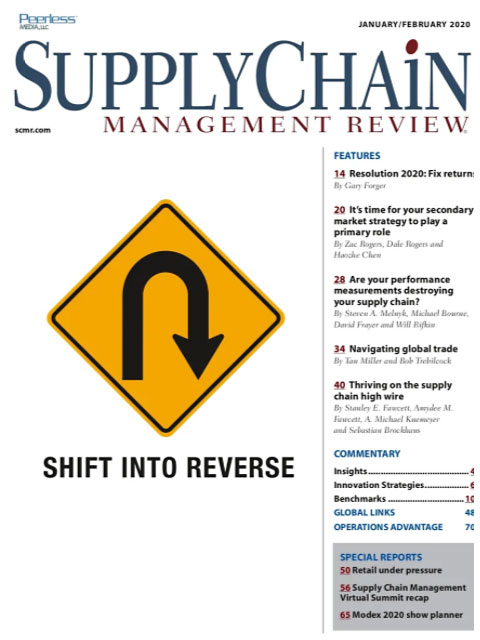Sorry, but your login has failed. Please recheck your login information and resubmit. If your subscription has expired, renew here.
January-February 2020
If the holidays at your household were like most, the gifts were chosen and wrapped with care, and then half were returned in the week after Christmas. Maybe more than half. After all, who among us hasn’t bought four shirts in a variety of sizes and colors with the intent of keeping one and returning three. And why not: Retailers and e-tailers alike have made returns seamless, easy and cheap. At least for the shopper. For the supply chains of the retailer, manufacturer or brand owner, returns are a once-neglected area that is growing into a major focus of supply chain managers who don’t want to see their organizations lose their shirt taking… Browse this issue archive.Need Help? Contact customer service 847-559-7581 More options
In light of the dramatic changes that supply chains have undergone over the last 20 years, companies need new, innovative approaches to supply chain design that shift the focus from cost-minimization toward value creation. And the design process must mature to capture the complexity, volatility and uncertainty of the competitive environment in which modern supply chains operate.
These challenges can be met with the support of advanced methods that combine the power of analytical models with the implicit knowledge of expert human-decision makers. The new approach improves decision-making transparency, enriches design solutions and reflects the real-life challenges that companies now face.
A new environment
The field of supply chain design is rooted in conventions developed through studies carried out in the 1990s. These studies primarily focused on the physical configuration of supply chains, such as facility location and customer allocation decisions. Supply chains were designed to minimize costs such as those associated with facilities, warehousing and transportation. Also, in the conventional approach, the design of a sup¬ply chain is typically reviewed once every few years; these exercises are rarely linked with tactical planning decisions.

This complete article is available to subscribers only.
Log in now for full access or start your PLUS+ subscription for instant access.
SC
MR
Sorry, but your login has failed. Please recheck your login information and resubmit. If your subscription has expired, renew here.
January-February 2020
If the holidays at your household were like most, the gifts were chosen and wrapped with care, and then half were returned in the week after Christmas. Maybe more than half. After all, who among us hasn’t bought… Browse this issue archive. Access your online digital edition. Download a PDF file of the January-February 2020 issue.In light of the dramatic changes that supply chains have undergone over the last 20 years, companies need new, innovative approaches to supply chain design that shift the focus from cost-minimization toward value creation. And the design process must mature to capture the complexity, volatility and uncertainty of the competitive environment in which modern supply chains operate.
These challenges can be met with the support of advanced methods that combine the power of analytical models with the implicit knowledge of expert human-decision makers. The new approach improves decision-making transparency, enriches design solutions and reflects the real-life challenges that companies now face.
A new environment
The field of supply chain design is rooted in conventions developed through studies carried out in the 1990s. These studies primarily focused on the physical configuration of supply chains, such as facility location and customer allocation decisions. Supply chains were designed to minimize costs such as those associated with facilities, warehousing and transportation. Also, in the conventional approach, the design of a sup¬ply chain is typically reviewed once every few years; these exercises are rarely linked with tactical planning decisions.
 SUBSCRIBERS: Click here to download PDF of the full article.
SUBSCRIBERS: Click here to download PDF of the full article.
SC
MR

Latest Supply Chain News
Latest Podcast

 Explore
Explore
Software & Technology News
- AI-driven sourcing: Why the speed of change is going to only accelerate
- Boeing turned to Fairmarkit, AI to help land its tail spend
- Is your enterprise suffering from too much data?
- Supply Chain 3.0: The power of connected data
- One door closes, a better one opens
- What really works in the digital supply chain?
- More Software & Technology
Latest Software & Technology Resources

Subscribe

Supply Chain Management Review delivers the best industry content.

Editors’ Picks





